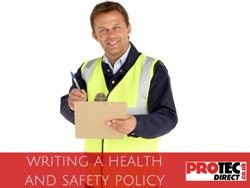All business need to have a health and safety policy but those with fewer than five employees are not obliged to write it down. However, those with more than five members of staff are legally required to have a written policy in place and available for all staff to access.
For most businesses (those with specific health and safety needs may be different) this will usually take the form of three written sections. This includes:
• A statement of general policy on health and safety at work
• A responsibility section
• An arrangements section
The general statement will outline your commitment to managing health and safety effectively and what the business wants to achieve in terms of its overall safety policy. The second section will include details about who is responsible for carrying out the specific actions outlined in the policy. The last section should include details about what practices are going to be put in place to ensure the aims of the policy are achieved.
An arrangements section
The arrangements section should also include information about the risks and hazards that will be associated with your workplace. Hazards are defined by the Health and Safety Executive (HSE) as anything that could cause harm to people while at work. Commonly these include electricity, chemicals, working at height and a number of others. The risk is considered to be the likelihood that anyone could suffer injury or illness because of these hazards.
The arrangements section should also include details about how staff are to be trained to recognise and avoid these risks, as well as including information about what personal protective equipment (PPE) is required to be worn in order to minimise this risk. There should also be guidelines around how risks are identified and signposted and other environmental factors, such as the floor and light conditions.
Tips for writing your policy
A health and safety policy does not need to be complex or confusing. A clear and easy to understand outline of the health and safety goals of the company should be followed by the job titles of who is responsible for this and an outline of the risks you can identify in your business. In short, it should clearly say who does what and when.
Staff should all be aware of the policy and be able to understand all the information that is contained within it. The policy should be consistent throughout the whole workplace and be relevant to the real needs of your staff. To that extent it is not enough to simply copy a generic health and safety policy and information should be individually tailored to your needs.
The policy will be dated and signed by the senior executive within the company, although it does not necessarily have to be created by them.
A clear statement of policy helps to ensure that everyone within a workplace is clear and informed about how to stay as safe as possible while at work.





Leave a comment